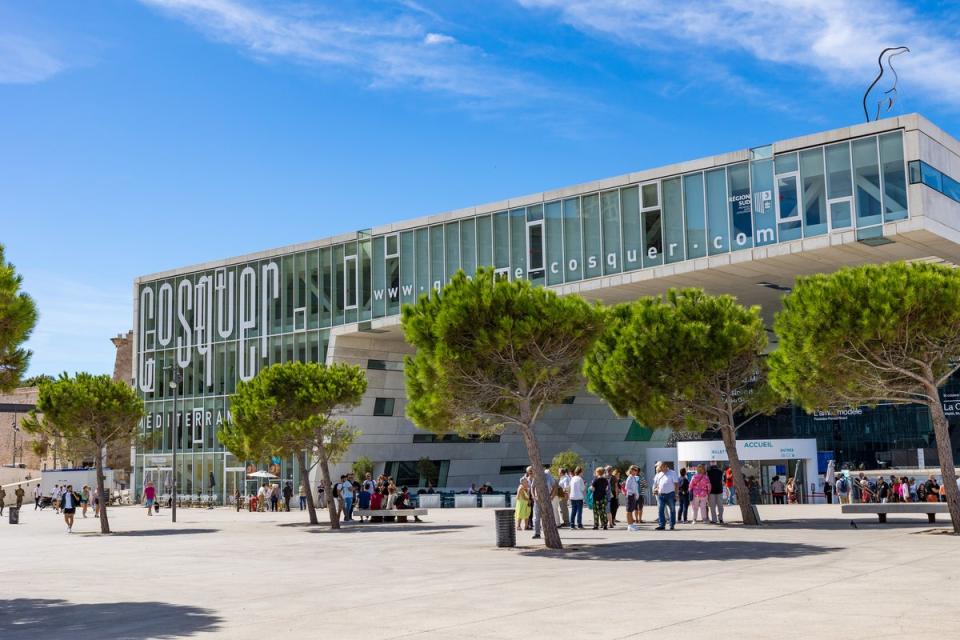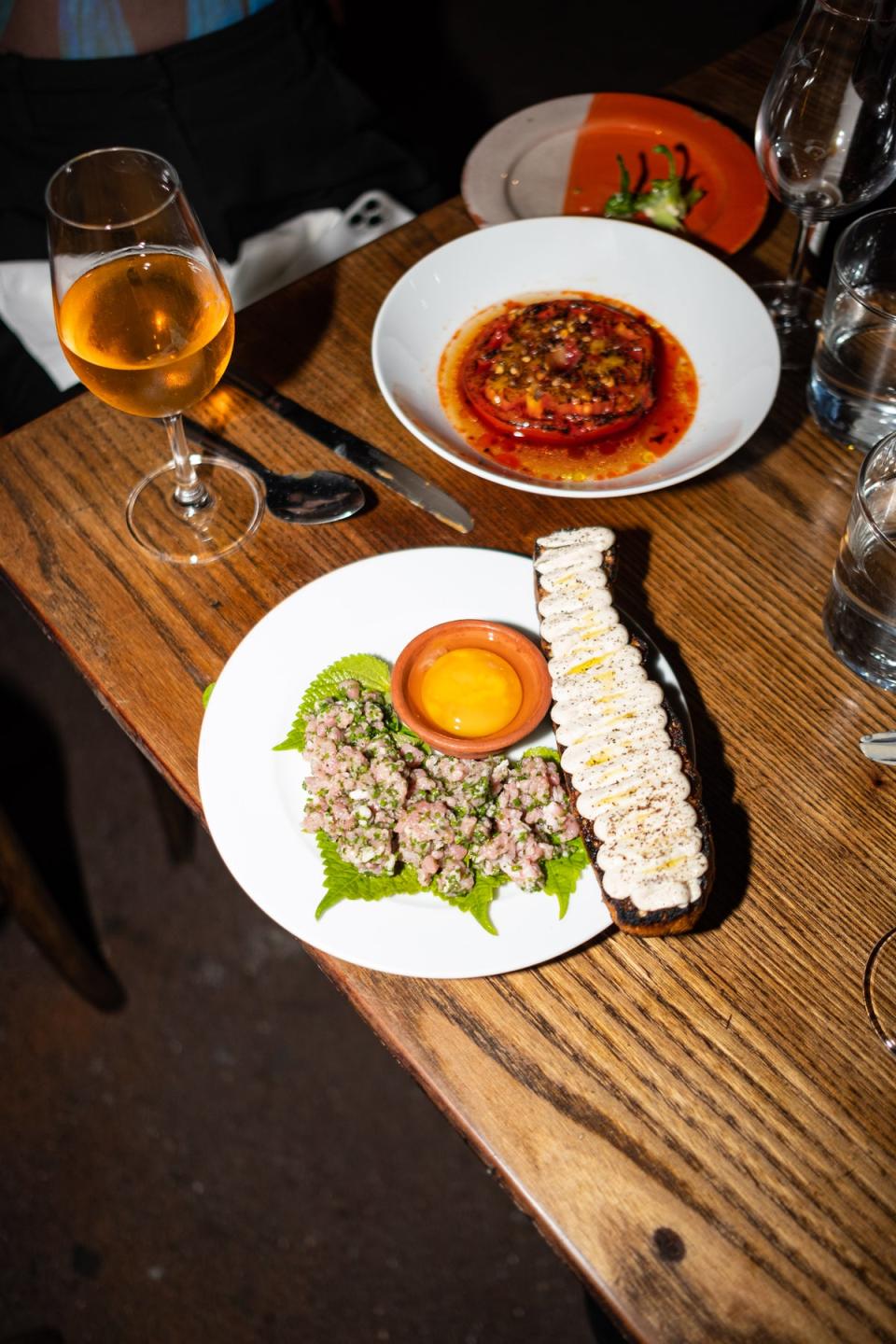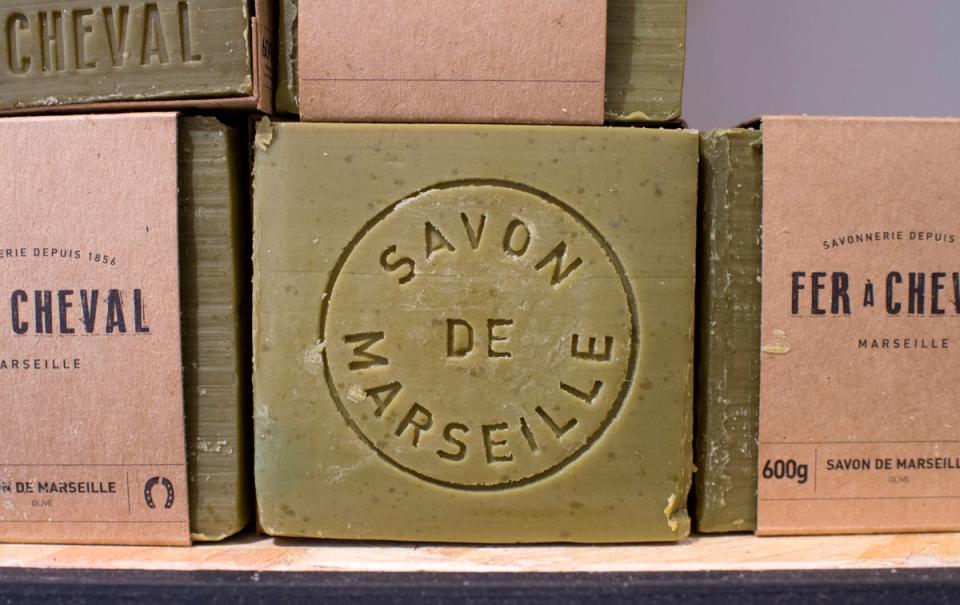Marseille city guide: Where to eat, sleep and drink in France’s cool, coastal second city

France’s second largest city has shaken off its downtrodden image in recent years to become one of the country’s coolest spots for a weekend break. Located less than three and a half hours by train from Paris, it’s a popular weekend and summer spot for Parisians who head down south in search of sun, sea, and arguably the most exciting culinary scene outside of the capital.
But make no mistake: Marseille has an energy and a charm that’s a world away from France’s more haughty capital. This rough-and-ready port city is a blend of cultures, with a vibrant daily market where you’re as likely to find North African snacks, pastries and flatbreads as you are fat olives and whole fish. The old port is a delight to wander around, while Marseille’s tenure as the European Capital of Culture in 2013 has left its mark in the form of the fabulous Mucem designed by Rudy Ricciotti (read more below) and the iconic Port Vieux Pavilion, a giant mirrored canopy.
Here’s how to make the most of a trip to this slice of coastal cool.
What to do
Head to the museums
Before the arrival of Mucem, Marseille’s culture offering was seriously lacking, but the city finally has a national museum to call its own. The now iconic building, designed by architect Rudy Ricciotti and encased in a high tech, super resistant concrete lattice, houses a collection of anthropological artefacts which explore the history of Mediterranean cultures. In addition to the permanent exhibitions, the museum hosts around six temporary ones each year, drawing world-famous artists such as Jeff Koons and Ai Weiwei to Marseille to make their own links between ancient civilisations and modern art.
Just next door is Cosquer Méditerranée, an underground replica of a large cave discovered back in 1985 by French diver Henri Cosquer on the coast of Marseille. The engravings, paintings, and handprints made on the walls of the cave â¯33,000 years ago are quite amazing, and the audio headset gives excellent information to bring it to life.

Musée Regards de Provence showcases local artists and their interpretations of Marseille and the surrounding region. Architecture fans may also appreciate the story of the gallery’s modernist-style building which, in a previous life, was a rather severe medical centre called La Station Sanitaire, used for conducting health checks on those arriving into Marseille’s busy port.
Why you should trade Cannes’ polish for Marseille’s gritty glamour
Wander round Le Panier

After years spent as one of Marseille’s more undesirable areas, the city’s old town, Le Panier, has now been transformed into one of its most charming. It’s easy to pass an afternoon wandering through its narrow streets, drifting in and out of independent boutiques and cafes, but there are a few historic sites to look out for. This includes one of the oldest townhouses in Marseille, the Hôtel de Cabre, which was actually moved from its original location and rotated by 90 degrees to align it with the newer streets.
Read more on France travel:
Head to the beach

There are two sandy beaches in Marseille: the more central Plage des Catalans and, further up the coastline, the Plage du Prophète. You might also spot locals simply sunbathing on the rocks that edge along the coast, but as this is more of a challenge for those with kids and buggies in tow, the beaches are the most popular spots for families. Bus 83 from the Vieux Port will drop you off at both.
Where to stay
If you want to be in the heart of Marseille then New Hotel Le Quai ticks all the boxes for a city centre hotel. Situated right by the Vieux Port, the rooms are large, attractive, and perhaps most importantly, quiet. You can also expect comfortable extras such as rain showers, fluffy bathrobes, L’Occitane products, and tubs on request.
If you’re looking for something a bit quirkier but still central, then check into Pension Edelweiss, a cosy B&B just a 10-minute walk from the Vieux Port. Owner Véronique Bieger has furnished each of the five guest rooms and common spaces with an eclectic mix of vintage furniture, and in the morning, breakfast is served for everyone to enjoy together (if you want) on the communal kitchen table.
To tap into Marseille’s highly creative art scene, consider booking a room at Pavillon Southway. Artist and art historian Emmanuelle Luciani has transformed this 19th-century home into a space decorated with artistic works and antiques so guests can truly live among art. You might even find yourself sharing the space with an artist in residence or, if you’re part of a group, asking about booking both rooms to have the place to yourselves.
If you’re visiting for a few days, then you won’t regret escaping the buzz of the city for a night at Tuba, Marseille’s hottest address. Located in the old fishing neighbourhood of Les Goudes, the hotel sits right on the rocky coastline for a truly spectacular view of the Mediterranean. The handful of rooms take designs cues from cute seaside cabins and guests are encouraged to embrace the hotel’s laidback beach vibes; throw your towel onto the rocks below for a spot of sunbathing, dip in and out of the cool blue water for a swim, or ask the team about a yoga class or snorkelling session. The hotel is closed during the winter months, but you can still enjoy the view from the excellent restaurant.
Read more of our France hotel reviews
Where to eat
Headed up by British chef Harry Cummins, La Mercerie is one of the restaurants leading the way in Marseille’s gastronomic revival. Whilst Cummins’ style is hard to define and has evolved since the restaurant opened, the chef is known for championing local Provençalâ¯produce (even if it’s served up in a very non-Provençal way) and his delicious homemade pasta. By night, its five-course tasting menu takes you on a journey through Harry’s creative cooking, and by day it’s a prix fixe menu (which always includes a veggie option) priced at €25 (£22) for one course, €35 (£30) for two, or €38 (£33) for three. Unlike other restaurants in Marseille, it’s also open on a Sunday.
Valentin Raffali cut his teeth at La Mercerie before taking charge of the group’s latest opening, Livingston. Situated in a laid back part of town where locals mingle in the street with a drink in hand, Valentine has replaced tasting menus with creative sharing plates that showcase a variety of influences; expect anything from the signature sourdough pizzetta, to whole Mediterranean mackerel with BBQ sauce and kimchi. The long list of natural and biodynamic wines might look intimidating, but don’t hesitate to tell the team what you like – or don’t – for a perfect pairing.

After working under the likes of Alain Ducasse at the Plaza Athénée in Paris, Marseille native Paul Langlère returned to his home town and opened Sépia. Housed in a former buvette (a kiosk selling drinks and snacks), the restaurant offers a unique location on the edge of Marseille’s oldest public garden and comes with panoramic views of the city. Flavours follow the seasons but expect to see contemporary takes on French classics; think pied de cochon (pig’s foot)and mousse au chocolat, and nods to the Mediterranean. Chef Langlère also isn’t afraid to experiment, whether it’s through the zingy flavours of garden-fresh herbs or unexpected pairings such as carrot cake with yuzu ganache. In summer, Bar Julis is open next door serving tapas and cocktails if you want to pop by for pre-dinner drinks.
Thanks to its position as France’s main port town, a number of nationalities have made Marseille their home over the years and influenced the city’s dynamic and ever-evolving food scene. Mama Africa (head to Le Cours Julien address if you want to dine al fresco on a terrace), Au Falafel (booking recommended), Chez Yassine, and Le Petit Nour d’Égypte (a street food spot on the main street,La Canebière) all offer a different taste of Marseille and make affordable spots for lunch.
The oldest bakery in Marseille is Four des Navettes, which has been hand making the city’s boat-shaped biscuits (navettes) in the same oven since 1781. They’re so good that the Archbishop of Marseille comes to the bakery on the morning of Candlemas (when they’re traditionally eaten) to bless both the oven and its orange blossom-scented treats.
Similarly to Paris, the sourdough trend is strong in Marseille. Pétrin Couchette, from the team behind La Mercerie, serves up rustic loaves, lunchtime sandwiches, and great coffee. For more traditional French pastries, head to T65.

If you need something more than a croissant to fuel a day’s walking up Marseille’s hills then swing by Carlotta With. Owner Charlotte Crousillat has taken inspiration from the kitchen of her Algerian-based Italian grandmother as well as her own travels to create her all-day brunch menu; think boiled eggs sprinkled with dukkah and orange-blossom pancakes topped with honey and pistachios. It’s also an address worth knowing about if you’re visiting Marseille’s main cathedral, Notre-Dame de La Garde, as it’s just a 10-minute walk away.
If you can’t be by the sea without an ice-cream, try L’Eléphant Rose à Pois Blancs by Cours Julien and Vanille Noire (closed in winter) next to La Panier for the best in town. If it’s a caffeine fix you need then Deep Coffee will deliver.
Where to drink

It’s a bold call to make but CopperBay Marseille has the best cocktails in the city. The sister address to CopperBay Paris serves up an ever-evolving seasonal menu but the signature drink to try is Le Mauresco, the bar’s riff on the traditional pastis-based apéritif Le Mauresque.
Speaking of pastis, the emblematic drink of Marseille, one of the best places to have one is on a sun-soaked terrace in Le Cours Julien, the hip artistic quarter. The large square is lined with bars and summer terraces; just pick a spot and (usually) order at the bar inside.
For a drink with a view, head up to CafeÌ de l’Abbaye which overlooks a small port and the Palais du Pharo, a palace offered to Napoleon III by the city Marseille, but which he never used. At the weekends, the place gets busy so if you can’t find a table there’s a couple of other lively bars further up the street which also set up terraces in summer.
Where to shop
Set aside a few hours to wander around Maison Empereur. The city’s iconic hardware shop, the oldest one in France, sells pretty much everything from paint and DIY tools to French baking equipment and gorgeous homeware. Most of the products feel charmingly old fashioned, particularly the traditional children’s toys, and even the cleaning products can be beautifully packaged. Be sure to stop by the soaps to pick up chunky blocks of Savon de Marseille (they make great gifts) and there’s also a café inside if you need to take a break from browsing.

Just across the street is Épicerieâ¯L’Idéal, a grocery store (épicerie in French) selling pasta, spices, olive oils, wine and much more, handpicked by founder and former food journalist, Julia Sammut. It has a deli counter inside for takeaway sandwiches and desserts and a fantastic restaurant just opposite (which is closed on Mondays, along with the shop, and also on Tuesdays).
For a traditional souvenir, stop by Marcel Carbonel to pick up some Santons of Provence. Meaning “little saints”, santons are tiny clay figurines which usually depict characters and animals from the nativity scene. There are around 120 santon makers still in the Provence region, and Marcel Carbonel have been making theirs since 1935. If you’re visiting in the weeks before Christmas, then you’ll also find some makers selling their collections at the Marseille Santon Fair by the Vieux Port.
Architectural highlight
No contest: it has to be la Cité radieuse (the radiant city), Le Corbusier’s imposing apartment block. It was originally designed as social housing before being eventually sold as private flats, and was heavily criticised when it first opened in 1952. It’s now protected by Unesco and one of the must-see sights of Marseille. If you wish to see an apartment, the tourist office has exclusive access to an empty one which has been left with its original Le Corbusier design and can organise excellent tours in English (or French).
Nuts and bolts
What currency do I need?
Euros.
What language do they speak?
French. In many addresses mentioned here you will find that most people speak great English too but in France it’s considered polite to start any interaction with a friendly “bonjour”, even if you end up switching to English.
Should I tip?
Five to 10 per cent, or simply round up a euro or two.
How should I get around?
Walking, if you can – you’ll see more of the city this way – but Marseille is big, even for a second city, and stretches far along the coastline rather than being concentrated in a circle like Paris. It’s also very hilly, so you might want to catch the bus or metro at some point, even when in the centre, to save your legs.
The bus service also takes you right along the coast on the Corniche Kennedy – the long main road which will take you as far up to places like Tuba in Les Goudes, and with a gorgeous view of the Med.
Any public transport ticket you buy can be used on the metro, bus, or tram as it’s all the same company. A single journey costs €1.50 (£1.30), plus €0.10 the first time you buy it as it comes on a reloadable card. A 10 trip card is €13.50 (£12), plus €0.10 for the first one, and a 24-hour pass (valid for 24 hours after you first use it) is €5.20 (£4.50). Note that on the bus you’ll need to buy your ticket from the driver, they only take cash only and prefer change (or at least a small note).
It’s also worth checking out the City Pass which not only includes entry into certain museums but also unlimited access on the bus, metro, and tram system for the duration of the pass. For adults, it’s priced at €27 (£24), €37 (£32) and €43 (£37) for 24, 48 and 72 hours, respectively.
What’s the best view?

In the city centre, Notre-Dame de la Garde will give you the highest, but you’ll see more of the Mediterranean and get a good view of La Cathédrale de La Major from the top of the Mucem; a popular photo is a combination of the museum’s modern concrete and the cathedral’s historic architecture.
Insider tip?
If you can, reserve restaurants in advance; Marseille is such a hot dining destination now that you’re taking a risk by winging it when you get there.
Remember that most addresses close on a Sunday and/or Monday, so check before you arrive. And if you arrive at Marseille Saint-Charles station by foot and can’t manage the stairs, you can cheat by passing through the metro; an escalator will take you down to the barriers where you can find more escalators to take you back up into the station.
Getting there
Trying to fly less?
You can travel from London to Marseille entirely by train: take the Eurostar to Paris, then transfer to Gare de Lyon for a direct TGV train to Marseille which takes just under three and a half hours.
Fine with flying?
British Airways, easyJet and Ryanair all fly direct from the UK to Marseille.

 Yahoo Lifestyle
Yahoo Lifestyle 
